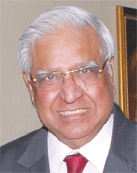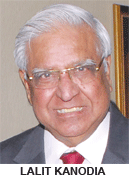Vocational education imperative
 Dr Lalit Kanodia is the IIT-Bombay and MIT, USA-educated founder-chairman of the Datamatics Group
Dr Lalit Kanodia is the IIT-Bombay and MIT, USA-educated founder-chairman of the Datamatics Group
As India’s economy develops, there will be mass migration from rural to urban India and by 2050, a mere 10 percent of the population will be rural. This implies that nearly 40 percent of our existing population, i.e. about 500 million citizens will migrate to India’s 7,900 cities and towns. The vast majority of them won’t qualify as engineers, lawyers, doctors or business professionals. They will be engaged in vocational occupations. FICCI has estimated that 95 percent of all jobs in India will be in the informal sector and that India will need a workforce of 500 million in the vocations by 2022! Unfortunately for mysterious reasons, during the past 65 years since independence very little attention has been paid by the Planning Commission or Central and state governments to promoting vocational education and training (VET).
Recently however, this long neglected subject has received modest national attention. While presenting the Union budget 2012-13 on March 16, former finance minister (now President) Pranab Mukherjee said: “At the end of ten years, projects (of the National Skills Development Corporation) are expected to train 620 million persons and augment training capacity by 12.5 million per year in the private sector.’’ Acknowledging the urgent need to promote VET, he proposed a 150 percent income tax deduction for expenditure incurred on skills development in the manufacturing sector. But while this belated awareness of the vital importance of VET for national development is commendable, it’s woefully short — as estimated by FICCI — of the nation’s needs.
Taking a leaf out of our past experience, we should unhesitatingly solicit help from countries which have successfully and fruitfully implemented vocational training. Prominent among them are Germany, Japan and the US. In this connection it’s pertinent to remember that IIT-Bombay was promoted with Russian assistance, IIT-Delhi, with help from the British, IIT-Kanpur with American and IIT-Chennai with German assistance. Similarly, IIM-Calcutta was established in association with MIT, Boston and IIM-Ahmedabad with Harvard University.
The Federal Republic of Germany perhaps has the oldest, best, most developed and well-conceptualised VET curriculums worldwide dating back to 1880s. Indeed, former president Horst Koehler of Germany on a visit to India in 2010, offered German assistance for vocational education. But there were no takers for this valuable proposal. Over 50 percent of high school students — and 2.5 percent of Germany’s 80 million people — are enroled for training in one of 344 trades from tannery to dental technician. Extrapolating from this, India should have 30 million students enroled in VET programmes. However, currently only 1 million youth in our country are receiving formal VET education. The US has a similar structure with vocational education being imparted by community colleges. Japan also has a well-organised VET system.
Although in 2008 the Union government promoted the National Skills Development Corporation, its equity capital is a mere Rs.10 crore. Moreover the responsibility for delivering VET is diffused between three ministries — finance, HRD and labour which is not conducive to efficient growth and development of VET.
According to the latest official available data (2005-06) the aggregate enrolment in technical and vocational institutes in India is about 3.5 million of whom 1.06 million are studying in ITIs/ITLs, 1.6 million are engineering and architecture students and 690,000 are enroled in short-term diploma programmes in polytechnics. In short, India is one of the few countries worldwide in which enrolment in engineering colleges and polytechnics exceeds that of vocational training institutes!
But there’s no doubt about the growing awareness of the vital importance of VET in India. I know of at least one philanthropist who is ready, willing and able to donate Rs.5,000 crore for providing structured vocational education and training in India. I’m confident that similarly, a very large number of enlightened Indians will be willing to contribute to this endeavour. Some chambers of commerce, too, are taking the initiative of setting up vocational training centres.
However, it’s important to note that establishing a viable and effective vocational training network requires collaboration between vocational training institutes, business and industry, chambers of commerce and Central and state governments.
Typically, the initial initiative and funding will be from government, as in the case of IITs and IIMs. Subsequently study programmes and training have to be imparted by VET institutes, with practical training and apprenticeship delivered by business and industry. Finally, the certification should be provided by chambers of industry and commerce.
Clearly, the case for a major thrust in vocational education is a national imperative. Today agriculture contributes 16 percent of GDP despite employing 52 percent of the population — a telling statistic of low productivity. If all rural youth receive VET, rural household incomes will rise five-fold, completely transforming the Indian economy.






 Dr Lalit Kanodia is the IIT-Bombay and MIT, USA-educated founder-chairman of the Datamatics Group
Dr Lalit Kanodia is the IIT-Bombay and MIT, USA-educated founder-chairman of the Datamatics Group










Add comment